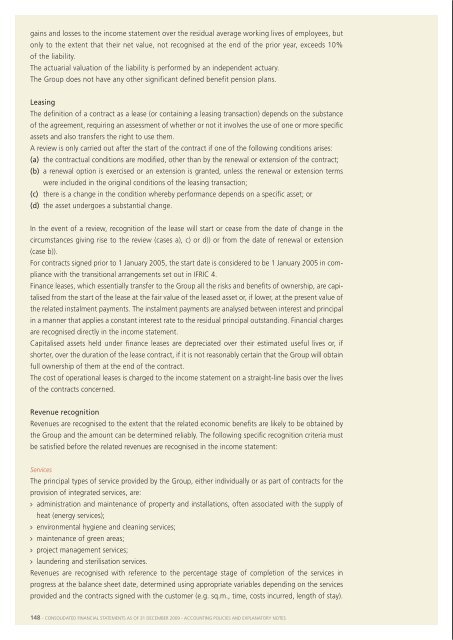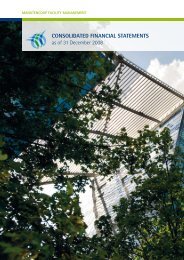Financial Statements 2009 - Manutencoop
Financial Statements 2009 - Manutencoop
Financial Statements 2009 - Manutencoop
Create successful ePaper yourself
Turn your PDF publications into a flip-book with our unique Google optimized e-Paper software.
gains and losses to the income statement over the residual average working lives of employees, butonly to the extent that their net value, not recognised at the end of the prior year, exceeds 10%of the liability.The actuarial valuation of the liability is performed by an independent actuary.The Group does not have any other significant defined benefit pension plans.LeasingThe definition of a contract as a lease (or containing a leasing transaction) depends on the substanceof the agreement, requiring an assessment of whether or not it involves the use of one or more specificassets and also transfers the right to use them.A review is only carried out after the start of the contract if one of the following conditions arises:(a) the contractual conditions are modified, other than by the renewal or extension of the contract;(b) a renewal option is exercised or an extension is granted, unless the renewal or extension termswere included in the original conditions of the leasing transaction;(c) there is a change in the condition whereby performance depends on a specific asset; or(d) the asset undergoes a substantial change.Services not completed at the accounting reference date represent “contract work in progress” andare classified among the trade receivables.Any revenues invoiced at the balance sheet date that exceed the amount accrued on a stage ofcompletion basis are deferred as advances from customers and classified together with trade payables.Even within multi-service contracts, the consideration for each service is generally defined separatelyand the amount of the revenues attributable to them is quantified as a reflection of their fairvalue.When the outcome of a service cannot be determined reliably, the related revenues are only recognisedto the extent that the costs incurred are deemed to be recoverable.Construction activitiesThe Group records revenues from construction contracts on a stage-of-completion basis, reflectingthe percentage of costs incurred with respect to the total estimated cost of completing the work.When the outcome of a contract cannot be determined reliably, the related revenues are only recognisedto the extent that the costs incurred are deemed to be recoverable.In the event of a review, recognition of the lease will start or cease from the date of change in thecircumstances giving rise to the review (cases a), c) or d)) or from the date of renewal or extension(case b)).For contracts signed prior to 1 January 2005, the start date is considered to be 1 January 2005 in compliancewith the transitional arrangements set out in IFRIC 4.Finance leases, which essentially transfer to the Group all the risks and benefits of ownership, are capitalisedfrom the start of the lease at the fair value of the leased asset or, if lower, at the present value ofthe related instalment payments. The instalment payments are analysed between interest and principalin a manner that applies a constant interest rate to the residual principal outstanding. <strong>Financial</strong> chargesare recognised directly in the income statement.Capitalised assets held under finance leases are depreciated over their estimated useful lives or, ifshorter, over the duration of the lease contract, if it is not reasonably certain that the Group will obtainfull ownership of them at the end of the contract.The cost of operational leases is charged to the income statement on a straight-line basis over the livesof the contracts concerned.Revenue recognitionRevenues are recognised to the extent that the related economic benefits are likely to be obtained bythe Group and the amount can be determined reliably. The following specific recognition criteria mustbe satisfied before the related revenues are recognised in the income statement:Sale of goodsRevenues are recognised on transfer to the purchaser of all significant risks and benefits derivingfrom ownership of the goods.InterestInterest income (calculated using the effective interest method i.e. the rate which exactly discountsthe expected future cash flows generated over the expected life of the financial asset to its net carryingamount) is recognised on an accruals basis.DividendsDividend income is recognised when the right of the shareholders to receive payment is established.Government grantsGovernment grants are recognised when it becomes reasonably certain that they will be collectedand that all the related conditions will be satisfied. When grants are associated with costs, they arerecognised as income each year on a systematic basis that offsets the related costs as they arise.The fair value of grants associated with assets is deducted from the carrying amounts of such assetsand, accordingly, is effectively released to the income statement on a straight-line basis over theexpected useful lives of the assets concerned via the systematic reduction of the related depreciationcharges.ServicesThe principal types of service provided by the Group, either individually or as part of contracts for theprovision of integrated services, are:> administration and maintenance of property and installations, often associated with the supply ofheat (energy services);> environmental hygiene and cleaning services;> maintenance of green areas;> project management services;> laundering and sterilisation services.Revenues are recognised with reference to the percentage stage of completion of the services inprogress at the balance sheet date, determined using appropriate variables depending on the servicesprovided and the contracts signed with the customer (e.g. sq.m., time, costs incurred, length of stay).Income taxesCurrent taxesThe current taxes due to or recoverable from the tax authorities are stated at the amounts expectedto be recovered or paid. The tax rates and regulations used to calculate the above amounts arethose in force at the balance sheet date.Deferred taxesDeferred taxes are calculated with reference to the temporary differences at the balance sheet datebetween the reported value of assets and liabilities and their value for fiscal purposes.Deferred tax liabilities are recognised in relation to all taxable temporary differences, except:> when they derive from the initial recognition of the goodwill or an asset or liability arising from atransaction that is not a business combination which, at the time of the transaction, had no effect148 - Consolidated financial statements as of 31 December <strong>2009</strong> - Accounting policies and explanatory notes Consolidated financial statements as of 31 December <strong>2009</strong> - Accounting policies and explanatory notes - 149








